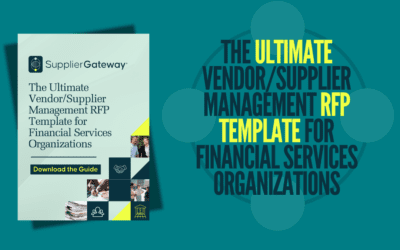Supplier Diversity Data Management: The Cornerstone of a Thriving Supplier Diversity Program
Updated April 7th, 2025.
A diverse supplier base is more than just good corporate citizenship—it’s essential for innovation, resilience, and financial performance. Engaging diverse suppliers can lead to significant cost savings, enhanced innovation, and improved supply chain stability. In fact, top-performing supplier diversity programs can generate up to 133% greater returns on procurement operations than average programs.
However, building and maintaining a successful supplier diversity program becomes challenging without a robust data foundation. Your organization might struggle with incomplete or outdated supplier data, lacking accurate insights into diverse supplier spend. Without foundational data, setting meaningful diversity spend targets or measuring your progress becomes virtually impossible.
Supplier diversity data management bridges this gap, serving as the critical foundation for a successful program. Accurate, comprehensive supplier information enables your organization to set informed goals, streamline supplier onboarding, identify opportunities, and measure real progress.
Defining Your Vision and Goals
Establishing clear, measurable goals is fundamental to driving success in your supplier diversity program. Here are the essential steps to clarify your vision and KPIs:
- Define Success Clearly: Whether your aim is a 10% annual increase in diverse supplier spend or improved retention of diverse vendors, set tangible, measurable targets.
- Secure Stakeholder Buy-in: Ensure that top executives actively support your program. Articulate supplier diversity’s strategic and financial advantages, aligning goals with broader organizational objectives to maintain sustained leadership support.
- Set Up Tracking Systems: Establish dashboards to monitor metrics such as the number of diverse suppliers included in bids, the percentage of spend with diverse businesses, and retention rates. Regular updates keep stakeholders engaged and informed.
- Develop Efficient Onboarding Processes: Streamline how you identify, attract, and onboard new diverse suppliers. Automation and clear communication enhance supplier engagement and reduce administrative burdens.
- Enhance Data Quality: Regularly audit and enrich existing supplier data to identify overlooked diverse suppliers. Verify certification status, capabilities, and contact details to optimize matchmaking between suppliers and sourcing opportunities.
Building an Effective Supplier Onboarding Process
Your supplier onboarding process is pivotal to collecting accurate, actionable data. Here’s how to implement an effective onboarding strategy:
- Develop a Comprehensive Supplier Application: Collect essential supplier data upfront, including certifications, capabilities, products/services offered, and ownership details through a user-friendly self-service portal.
- Verify Supplier Credentials: Require suppliers to submit supporting documentation confirming their diverse status and other critical certifications. This step ensures data accuracy and compliance.
- Perform Thorough Risk Assessments: Evaluate financial stability, insurance coverage, quality certifications, and other factors essential to your supply chain’s reliability.
- Engage Directly with Suppliers: Use interviews or video conferences to clarify supplier capabilities, address queries, and assess alignment with your business needs.
- Centralize Supplier Data: Enter verified supplier details into a centralized supplier management system, creating a single source of truth for easy reporting and monitoring.
Supplier Diversity Data Management Best Practices
Effective management of supplier diversity data requires ongoing attention. Implement these best practices to maintain high-quality data:
- Enable Supplier Profile Maintenance: Allow suppliers to update their profiles directly, keeping ownership, certifications, revenue, and capabilities information current.
- Regular Data Validation: Conduct periodic reviews to confirm that supplier statuses and certifications remain accurate and valid.
- Consistent Reporting: Regularly generate reports tracking diverse supplier spend, the number of active diverse suppliers, and diversity spend as a percentage of total procurement.
Leveraging Data for Continuous Improvement
Utilize your data to drive continuous improvements in your supplier diversity program by:
- Analyzing Spend Data: Identify categories or groups where diverse supplier spend can be increased and develop targeted strategies.
- Recognizing High Performers: Highlight top-performing diverse suppliers, offering expanded opportunities or mentorship roles to sustain engagement.
- Addressing Underperformance: Identify suppliers struggling to meet performance benchmarks, offering support or training to enhance their capabilities.
- Refining Program Components: Regularly seek feedback and identify patterns in your data to enhance certification processes, matchmaking events, supplier training, and overall user experience.
Navigating Supplier Diversity in Today’s Political Climate
In today’s evolving political environment, where Diversity, Equity, and Inclusion (DEI) initiatives face increased scrutiny, supplier diversity programs must adapt proactively. Recent legal and political developments, such as adjustments made by companies like McDonald’s and Kohl’s, underscore the importance of careful and compliant program design.
Best practices for navigating these challenges include:
- Secure Leadership Commitment: Ensure executive leaders visibly support and champion supplier diversity initiatives.
- Develop Clear Policies and Goals: Clearly document objectives, scope, and measurable targets for diverse supplier engagement.
- Enhance Communication Strategies: Transparently communicate program progress and successes internally and externally.
- Mentor and Support Diverse Suppliers: Provide resources and support to enhance suppliers’ competitiveness and integration into your supply chain.
- Regularly Review and Adapt Programs: Continuously assess the program’s effectiveness, adapting to the evolving political and regulatory landscape.
Conclusion
Effective supplier diversity data management underpins a robust supplier diversity program. Accurate data enables informed decisions, clear goal-setting, and measurable impact. With a strong data foundation, your program can transform from a positive intention into a strategic advantage.
Ready to enhance your supplier diversity program with data-driven strategies? Connect with our experts today to get started.












